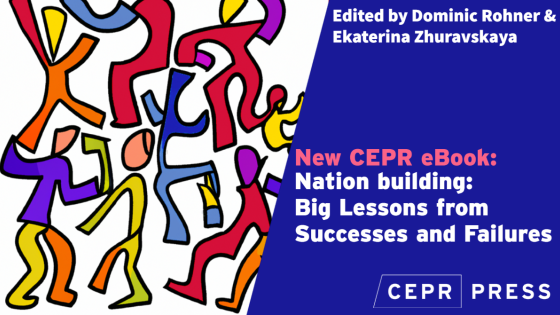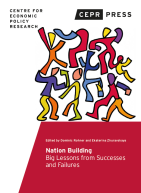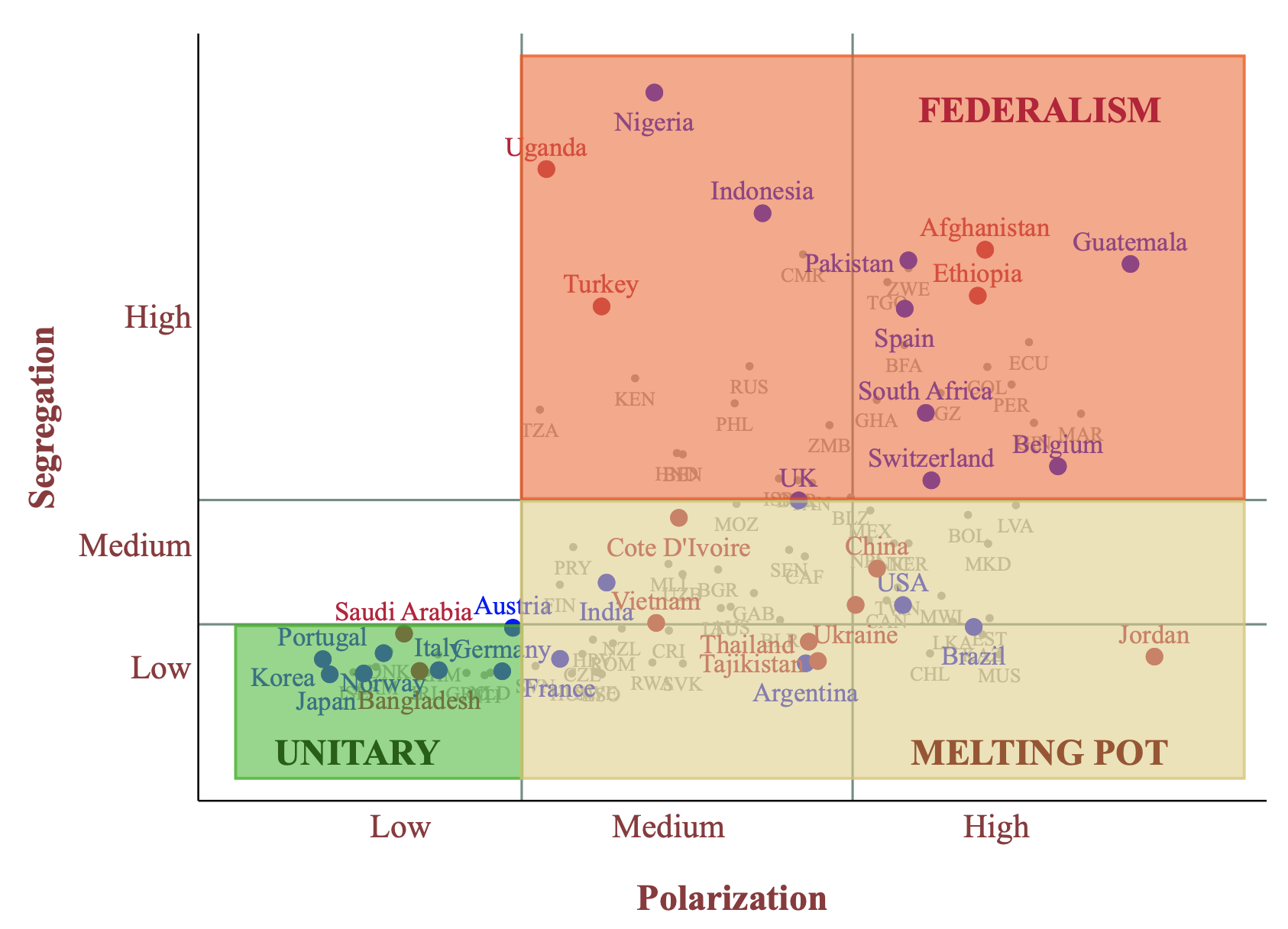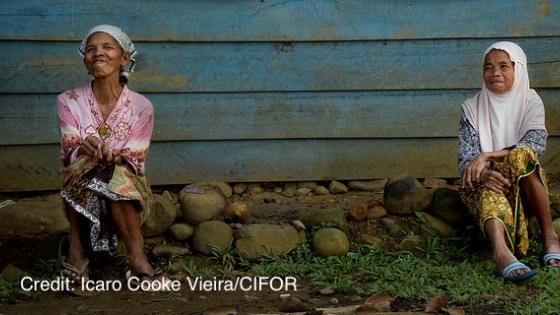First, the conditions under which countries undertake nation building policies vary widely, and there are many external and internal factors that influence their effectiveness. We single out two factors that are particularly important for nation building: group polarisation and segregation. Group polarisation reflects potential salient antagonism within society. High polarisation means that there are few powerful groups. It is highest when there are two equal-sized groups, as it is the easiest to focus on group divisions in this case. By contrast, segregation measures the extent to which representatives of different groups within a country live in separate areas. Segregation is highest when the country is divided into regions with homogenous populations, and lowest when the group composition of the population is the same in all parts of the country.
Figure 1, taken from our introduction to the eBook (Rohner and Zhuravskaya 2023b), where the data are also described in detail, presents the position of modern countries along the axes of ethno-linguistic polarisation (x-axis) and ethno-linguistic segregation (y-axis). Most countries are labelled with their country code in light grey. A few countries are highlighted, with their full names spelled out and their level of democracy indicated. Blue labels correspond to highlighted countries classified as mature democracies by Polity IV in 2018, with a Polity2 score of 6 or above. Red labels indicate highlighted countries with a lower level of democracy, with a Polity2 score of 5 or below in 2018.
At the risk of over-simplifying, we can classify countries into three groups based on their level of polarisation and segregation, singling out Max Weber’s ‘ideal types’. The first group is characterised by low levels of both polarisation and segregation. These countries have relatively low diversity compared to other countries in the sample, and typically do not have strong secessionist movements or internal ethnic conflicts. Fostering a common national cohesion may be less challenging in a homogenous state than for a diverse country, as homogenous states are able to build national cohesion around common cultural features, such as a common language and common ethnic history, in contrast to multi-ethnic states which need to rely on more complex forms of identity. Yet, the national cohesion in low-polarisation states may feature a dark side: aggressive nationalism. It is worth noting that many countries with large-scale fascist movements in the 1930s and 1940s, such as Germany, Italy, Japan, and Austria, were located in this corner of the chart. Put simply, while this corner offers a relatively easy prospect for society-wide national cohesion in democratic regimes such as in Germany, Italy, Japan or Austria today, it carries a significant risk of aggressive nationalism when non-democratic regimes are in place, as was the case in these countries during the 1930s and 1940s.
The second category of countries that we consider have high ethno-linguistic segregation (these countries have medium to high level of polarisation). The population, which is ethnically (or religiously) homogenous within regions and different between regions in these countries, is likely to develop regionalist identity, which could mean that they reject a national identity. Highly segregated countries face a serious risk of instability, separatist movements, and civil conflicts, as illustrated by two countries that no longer exist: the Soviet Union and Yugoslavia. Not all countries with a high level of segregation are doomed, however. A model case in this group is Switzerland, which has managed to put in place a set of inclusive institutions and power-sharing that do not require cultural homogeneity. Northern Ireland, Spain and post-Apartheid South Africa are other examples of countries with quite high ethno-linguistic segregation that have managed – despite substantial inter-group violence in the past – to maintain peace in recent years. In contrast, in many high-segregation countries classified as non-democracies that do not have effective power-sharing institutions (such as Afghanistan, Turkey, Ethiopia, and Uganda), ethnic tensions have exploded into full-blown wars in recent decades.
The third and last category of countries is located in the bottom-right corner. They have medium to high polarisation but relatively low (medium to low) segregation. Due to high polarisation, these countries have inherent group divisions, but these divisions do not have a geographical dimension. Representatives of different groups live in close proximity all around the country. Secession and a split into different states in this case is not an option. Thus, there is essentially only one option for them to avoid conflict: make the group differences less salient by fostering national identity, for instance through public education (Blanc and Kubo 2021) and shared positive experiences (Depetris-Chauvin et al. 2020).
From the discussion above and the insights from research presented in the eBook, it is clear that countries face different challenges in their paths to social cohesion depending on their initial conditions. Thus, their nation-building strategies should also be different. Countries with low ethno-linguistic diversity and, thus, low levels of polarisation and segregation (green area on the figure) can build a ‘unitary’ system with a strong sense of national identity and a common narrative. It is important, however, to keep in mind the dangers of aggressive nationalism which could accompany such common narratives in autocratic regimes. Thus, the tasks of democratisation and of consolidating democracy are crucial for the long-term successful nation building and prosperity.
Figure 1 Nation Building strategies
Polarised countries with low segregation (yellow area on the figure) may want to focus on minimising the salience of group divisions. We label this strategy ‘melting pot’. Focusing public education on embracing inclusion and diversity, together with providing equal opportunities for different groups and making benefits of shared positive experiences more salient, is crucial for countries with these initial conditions. In addition, opening up borders to immigration and therefore allowing even larger diversity may actually help to attenuate intergroup tensions, as it would decrease polarisation and make ‘melting pot’ policies more efficient.
Finally, the best hope for nation building in countries with high segregation is to recognise and embrace the existing divisions by building a decentralised system with effective power-sharing between different segregated groups. With these initial conditions, assimilation of minorities may hardly be achievable in a democratic setting. Instead, the country needs to focus on integrating them into democratic political processes. We refer to this strategy as ‘federalism’.
After having sketched the big picture of different state trajectories and strategies, the eBook discusses in more depth the key ingredients of nation building, describing the insights of research presented in each book chapter one by one. The chapters are organised into five distinct, but related sections. The first section considers the role of social interactions, and in particular contact versus social identity. The second focuses on the role of education in nation building. The third considers propaganda, leadership, and joint experiences. The fourth section tackles the role of external interventions and wars. The fifth section considers the role of representation and redistribution and considers the question of what motivates leaders to invest in nation building. Drawing on the insights of the eBook, five key lessons can be formulated:
- Democracy is the backbone of sustainable and peaceful nation building. First of all, as shown throughout the book, the fate of nation states in all zones of the polarisation–segregation space are more favourable for democracies. This is particularly crucial in the zone of low polarisation and low segregation, when the nation-building strategy is in building a unitary state with a strong national identity, as democracy helps escape the perils of nationalist madness and fascism in this context.
- Inter-group contact with horizontal equality and security guarantees can reduce inter-group animosity and promote a melting pot society. As shown in Section II of the book, in high-polarisation settings, more peaceful and fair interaction between groups nurtures inter-group trust. Importantly, local and national identities are not mutually exclusive. They are not a zero-sum game, as positive interaction can foster a sense of belonging to both the country and a local community.
- Fostering a positive common identity, for example through education, is key with high polarisation and low segregation. In countries with high ethnolinguistic polarisation, where the groups share the same territory, fostering a common inter-group identity by building a ‘melting pot’ society is the only way to avoid discrimination and inter-group hostilities. As shown in Sections III and IV of the book, while democracies typically stress positive values of tolerance and common destiny through public education, some autocracies choose indoctrination and defamation of minorities both in education or through media propaganda with often dire consequences. Reducing polarisation by opening up to diverse migrants could reduce salience of the group divisions and facilitate the melting pot.
- Power-sharing and federalism are crucial in high-segregation settings. As shown in Section VI of the book, power-sharing and federalist policies provide the glue holding together high-polarisation, high-segregation countries.
- Unilateral military interventions and military aid often backfires in terms of their effect on attitudes of local population, yet UN peacekeeping security guarantees work to reduce conflict. As shown in Section V of the book, nation building pursued militarily from outside faces many risks and pitfalls, but multilateral UN peacekeeping can create the favourable ground conditions for national reconciliation in post-conflict settings.
Authors’ note: This column draws very heavily on the introductory chapter of the eBook (Rohner and Zhuravskaya 2023b), reproducing several segments of the text.
References
Alesina, A and E Spolaore (1997), "On the number and size of nations", The Quarterly Journal of Economics 112(4): 1027-1056.
Blanc, G, and M Kubo (2021), “Schools, Language, and Nations: Evidence From a Natural Experiment in France”, Working Paper-Brown University.
Depetris-Chauvin, E, R Durante, and F Campante (2020), "Building nations through shared experiences: Evidence from African football", American Economic Review 110(5): 1572-1602.
Querubin, P and M Dell (2016), “More bombs, more shells, more napalm: Nation building through foreign intervention”, VoxEU.org, 16 August.
Rohner, D and E Zhuravskaya (eds) (2023), Nation Building: Big Lessons from Successes and Failures, CEPR Press.
Rohner, D and E Zhuravskaya (2023b), “Nation Building: What Could Possibly Go Wrong?”, in D Rohner and E Zhuravskaya (eds), Nation Building: Big Lessons from Successes and Failures, CEPR Press.
Wong, M, A Gaduh, A Rothenberg and S Bazzi (2018), “How intergroup contact can foster nation-building”, VoxEU.org, 7 January.




